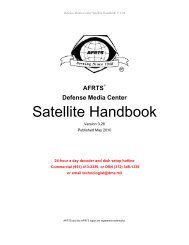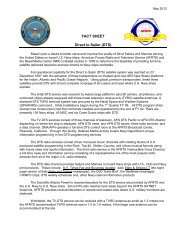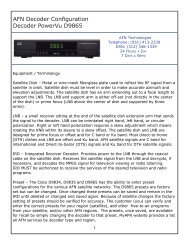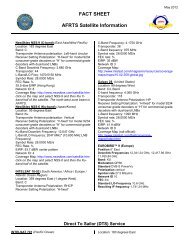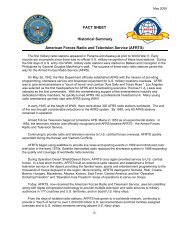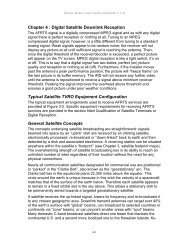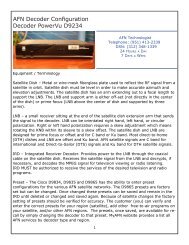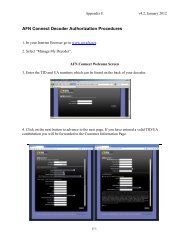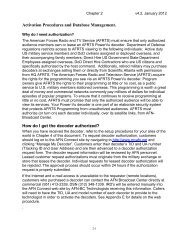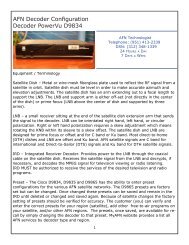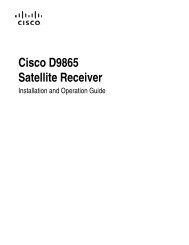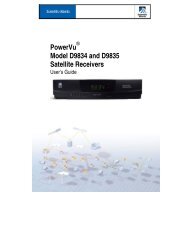AFRTS Defense Media Center Satellite Handbook
AFRTS Defense Media Center Satellite Handbook
AFRTS Defense Media Center Satellite Handbook
Create successful ePaper yourself
Turn your PDF publications into a flip-book with our unique Google optimized e-Paper software.
<strong>Defense</strong> <strong>Media</strong> <strong>Center</strong> <strong>Satellite</strong> <strong>Handbook</strong> V.3.26<br />
These interfering carriers are usually out-of-band and can be dealt with by<br />
installing a C-band block filter that can be specifically manufactured for greater<br />
protection at the aircraft radar frequency.<br />
Other potential sources of interference from airports are ground looking radar<br />
that can saturate LNA/LNB’s. Frequency coordination in some countries allow for<br />
adjacent bands to be utilized where they can cause out-of-band interference.<br />
Once again, C-band band pass or block filters remain an effective means of<br />
controlling the interfering carrier.<br />
Ship-board Radar<br />
Another potential source of interference in coastal areas is shipboard naval<br />
radar. Usually, this on-board radar is not supposed to be utilized within a radius<br />
of the shore; however, there are documented cases where this radar has been<br />
“turned on” with deleterious effects to the local coastal viewing audience.<br />
Commercial Microwave Ovens<br />
Commercial microwave ovens operating in fast-food chains and earth station<br />
lunchrooms are potential sources of interference. Emissions levels allowed by a<br />
microwave oven can be as much as 20 dB higher than a C-band satellite carrier;<br />
however, microwave oven manufactures are normally required to replace units<br />
that are known to interfere with commercial broadcast systems. A typical<br />
operating frequency for a microwave oven is 2250 MHz with a considerable<br />
amount of wide band noise generated in the 3900 MHz to 4500 MHz range. This<br />
noise can become more apparent over the life of the magnetron and can be<br />
prevalent near the end of its useful life.<br />
Walkie-Talkies<br />
Walkie-talkies have been observed to interfere with the operation of IRDs.<br />
Operating a walkie-talkie in the vicinity of the IRD can interfere with the operation<br />
of the IRD. Restricted use of walkie-talkies is recommended in the vicinity of a<br />
downlink earth station.<br />
Cell Phones<br />
Cell (Cellular) Telephones operate in the 900 Mhz range and can directly<br />
interfere with the down converted (IF) signal from the LNB to the IRD. The<br />
activation of a cell phone unit near the IRD may generate unacceptable<br />
destructive or out of band interference which may enter the IRD through poorly<br />
shielded cabling or improperly terminated dividers and connectors.<br />
Random RFI (Fluorescent and Sodium Vapor Lamps, Lightning)<br />
Particularly on start-up, fluorescent lamps can flicker causing an interfering<br />
source to an earth station antenna nearby. Another potential source is sodium<br />
vapor lamps when in a “failed” condition. Lightning is another known source of<br />
RFI that can effectively wipeout both digital and analog carriers. Though these<br />
sources are not a common occurrence, they should be mentioned in the<br />
investigation of a RFI occurrence.<br />
4-16



